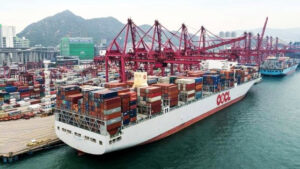The global orderbook for containerships continues its unabated growth. The latest comes from Hong Kong-based Orient Overseas International, part of the COSCO Shipping Group, which announced an investment of $1.6 billion to continue the rapid expansion of the company’s fleet.

According to a filing with the Hong Kong Stock Exchange, OOIL placed an order for 10 new 16,000 TEU boxships to be built by two shipyards in China. The contact will be evenly split between Dalian Cosco KHI Ship Engineering (DACKS) and Nantong Cosco KHI Ship Engineering (NACKS), operated as a joint venture between Cosco and Japan’s Kawasaki Heavy Industries.
Few details were offered on the individual vessels other than to say that be equipped with energy-saving and emission reduction technologies, which will generate cost advantages for Orient Overseas Container Lines which will operate the vessels. Delivery is expected between the fourth quarter of 2024 and the fourth quarter of 2025.
The latest order is a follow-on to two orders placed in 2020 with the same shipyards for a total of 12 containerships, each of which will have a capacity of 23,000 TEU. The larger vessels are due to begin delivery in 2023 and complete in 2024. OOIL stressed the benefits of working with the same shipyard for both orders as they “have gained an improved understanding of the group’s operations and technical specifications, requirements and standards for its newbuildings.” Further, they reported that the two yards have open docks and the capacity for new orders of NeoPanamax vessels.
Cosco launched the rapid growth of OOCL in 2017 with the introduction of six new G Class containerships each with a capacity of 21,413 TEU. The vessels are significantly larger than OOCL’s previous class which has a capacity of 13,208 TEU. Currently, the line is operating 61 vessels with a total capacity of 542,400 TEU. The new orders represent an 80 percent increase over the company’s current total capacity.
Read Also: Israel Opens New Chinese-Operated Port
“The increase of self-owned vessels as a result of the transaction would complement the group’s long term strategic development and growth plan to meet market demand in the future,” OOIL writes in the filing. They highlight the ability to optimize its fleet structure, reducing the reliance on chartered vessels. The larger size they also highlight increases the average container space driving economies of scale resulting in a lower cost per container.
The company projects that 40 percent of the $1.6 billion price tag for the new vessels will be paid from internal resources with the remainder bank financed. OOIL recently reported strong financial results for the first half of 2021. Like the other major carriers, OOIL reported revenues doubled reaching nearly $7 billion on a nearly 20 percent increase on the number of TEU transported. The carrier reported an operating profit of more than $2.8 billion versus $155 million a year ago.
Kindly like us on Facebook
















Discussion about this post